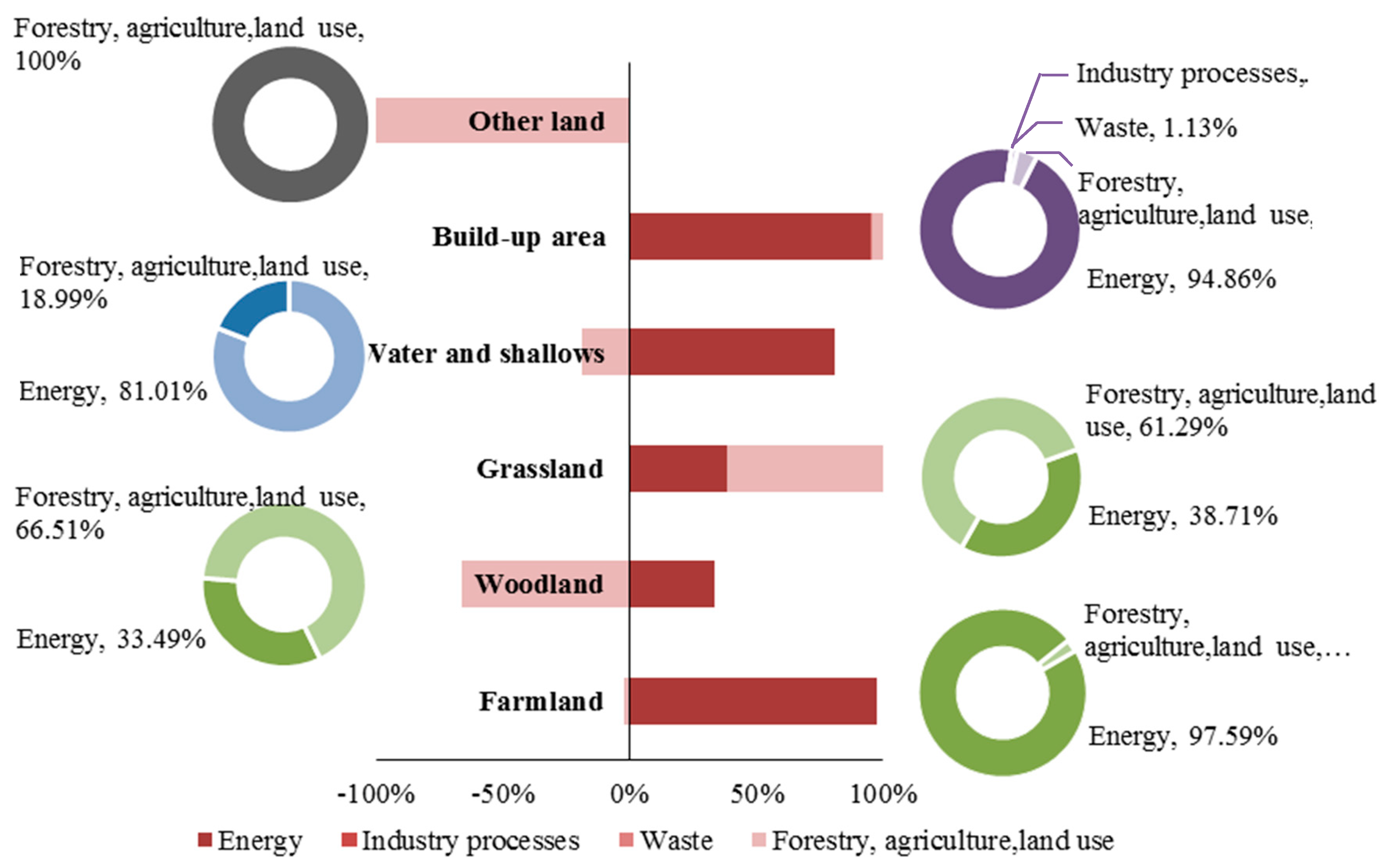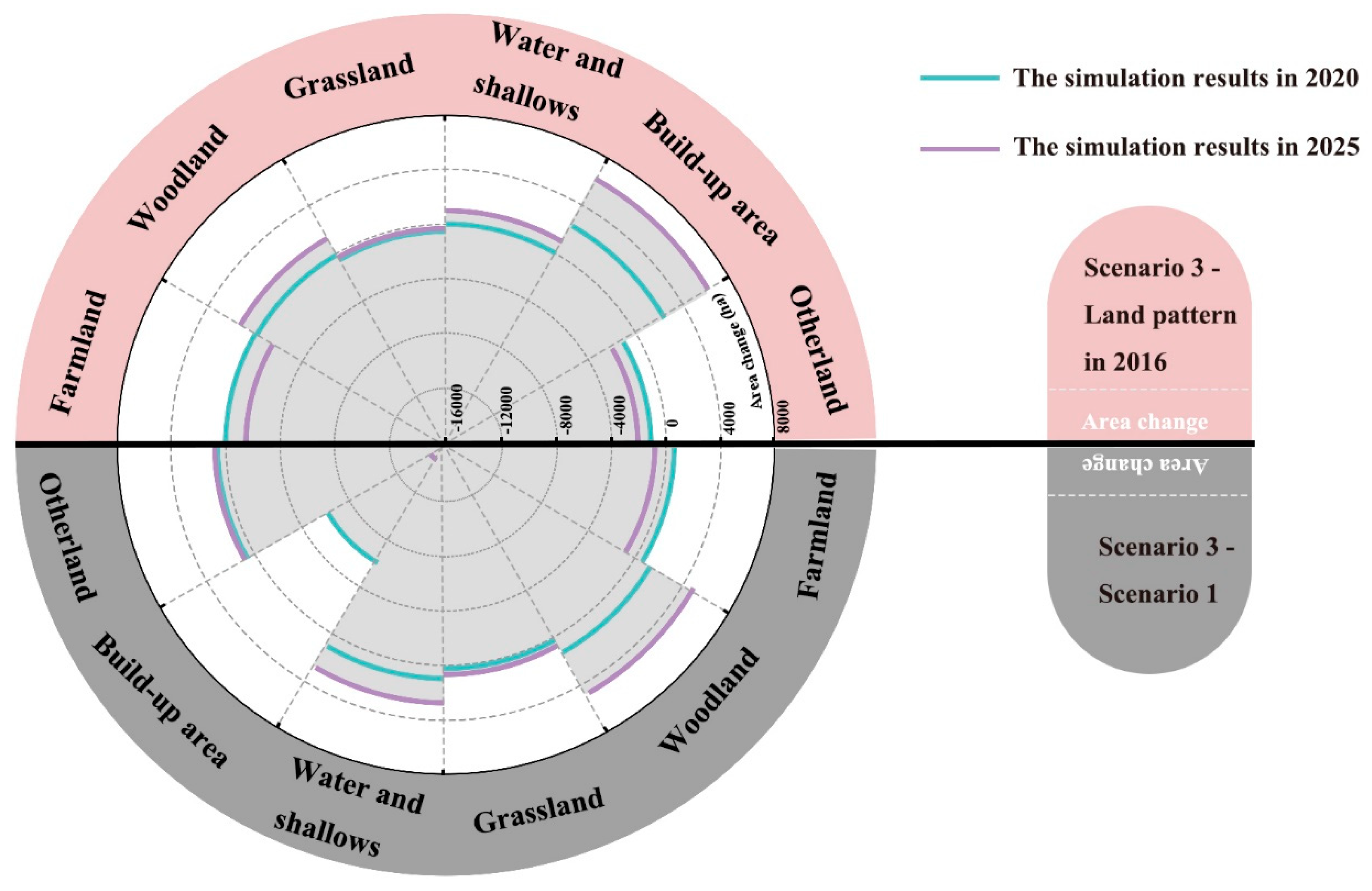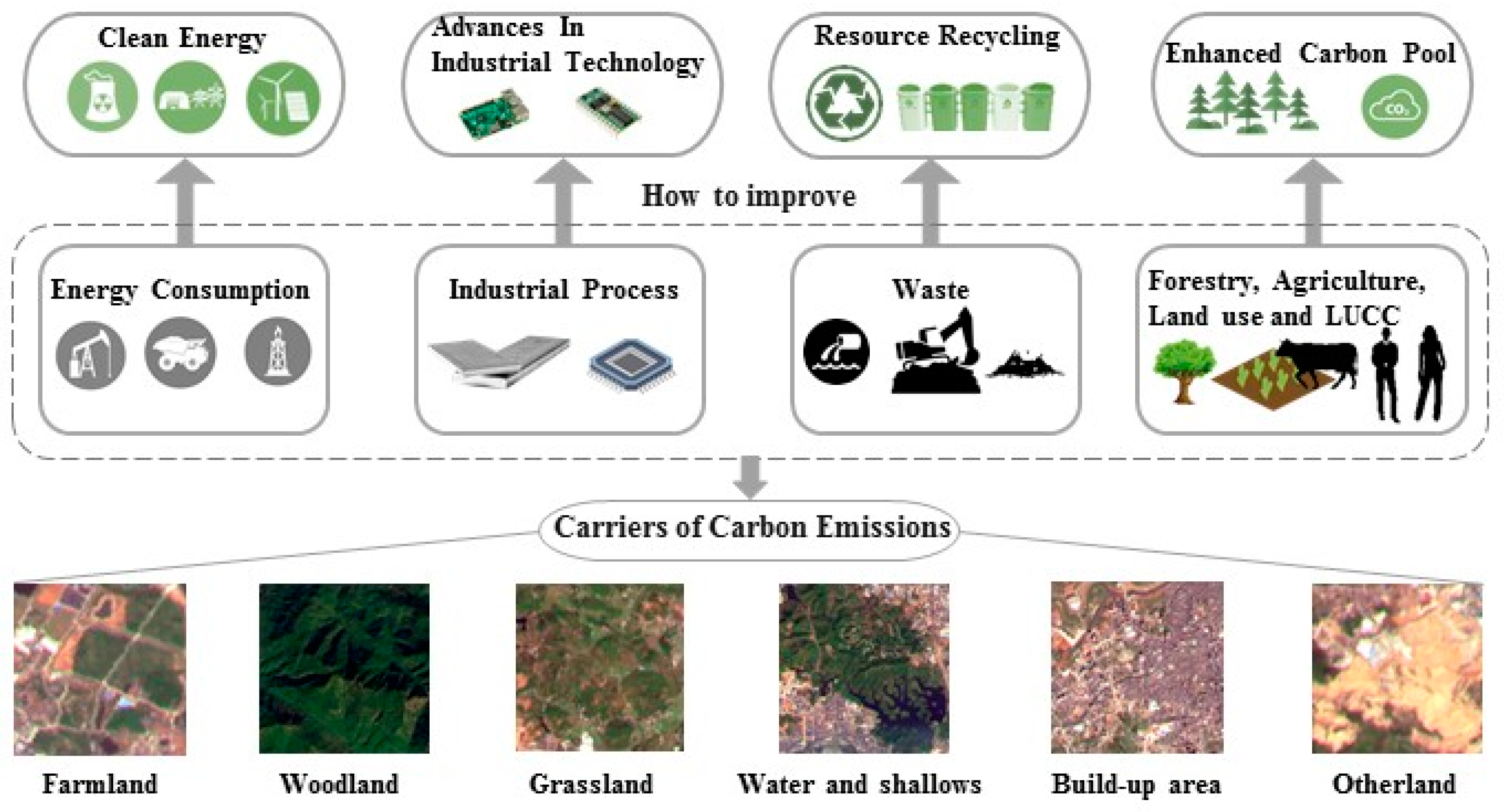2.2. Data Sources
This study mainly includes data on land use and land cover, energy consumption, waste quantity, population, gross domestic product, principal crops, livestock, industrial products, and carbon sink values of various terrestrial ecosystems.
The land-use and land-cover datasets are from the Chinese Academy of Sciences Resource and Environment Data Cloud Platform [
22]. This work classifies the land-use types in Shenzhen as farmland (2.03%), woodland (40.71%), grassland (1.23%), waters and shallows (9.72%), built-up areas (43.23%), and other land (3.08%), including bare and unused land. The Shenzhen Statistical Yearbook provided the energy consumption data [
23]. China Emission Accounts and Datasets supplied the energy carbon emission factor [
24]. The Shenzhen Municipal Bureau of Statistics provided the population, GDP, primary crop yield, animal husbandry, and industrial production data. Other empirical data came from studies published by the IPCC and other researchers [
14,
25,
26,
27,
28,
29].
2.4. Assignment of Carbon Emissions to Various Land-Use Types
Using local data and previous studies [
14], we divided the various land-use types in Shenzhen according to the four factors that contribute to carbon emissions, as established by the IPCC (
Table 1).
In the case of farmland, carbon emissions are mainly due to the energy consumption of mechanized agricultural production, fertilizer losses, and crop respiration. Farmland mainly relies on vegetation and soil to absorb carbon.
Energy consumption in mechanical operations and the biological respiration of forest ecosystems are considered to be the primary sources of carbon emissions from forest land. Woodland has a vital carbon sink capability, mainly from carbon sequestration by vegetation and soil.
The carbon absorption pathway of grassland is similar to that of forest land. Nevertheless, its emissions are mostly due to biological life activities, including respiration, intestinal fermentation, and feces, as well as energy consumption in animal husbandry production.
Water and shallows are important types of land use in coastal cities; they mainly rely on the soil in shallows to absorb carbon. Energy consumption from fisheries is a major source of carbon emissions.
In built-up land, energy consumption is mainly due to the various industries, industrial products, waste, and human respiration, as shown in
Table 1, whereas urban green areas absorb carbon.
As for other land types, including idle land, sandy ground, and bare land, carbon emission and absorption are mainly determined by the ability to release and fix carbon in soil.
2.6. MOLP Model Development
This study used a MOLP model to optimize land-use structure, including the development of objective functions and constraints using the LINGO software (version 10.0). Because China’s national development plans are updated every five years, the MOLP model explored potential land-use structures to be developed by 2020 and 2025. The three future scenarios of the model were: (a) the natural scenario, which only considered land demand to promote urbanization and economic development and in which the change trends in the various land-use types were based on the rate of land-use change from 2012 to 2016; (b) the low-carbon scenario, which aimed at reducing carbon emissions (Equation (13)); and (c) the low-carbon economy scenario, which took the requirements of low-carbon targets into account to achieve maximum economic development (Equation (14)):
In Equation (12),
i = 1, 2, …, 6, represents farmland, woodland, grassland, water and shallows, built-up land, and other land, respectively.
(t/hm
2·a) is the carbon emissions coefficient of land type
i (
Section 2.5), and
(hm
2) represents the area of land type
i. In Equation (13),
(hundred million/hm
2·a) is the economic benefit coefficient of land type
i (
Section 2.5). According to the indicator system used in Shenzhen to tackle climate change, carbon dioxide emissions are required to be less than 0.6 t per 10,000 Yuan of GDP. In other words,
is used to explore the maximum economic benefit under the carbon emissions indicator.
Seven constraints were established depending on local land-use policies, the plans for economic and social development, and particular restrictive land-use conditions. According to the land-use plan for Shenzhen from 2005 to 2020, the total area in 2020 will reach 201,219 hm
2. Based on the growth rate of the total area from 2016 to 2020, the total predicted area in 2025 will be 205,388.65 hm
2. Therefore, the first constraint (total area constraint) of the optimization model in 2020 can be established as follows:
Shenzhen has focused on economic development, and agricultural lands have decreased irreversibly. Therefore, government and scientific researchers have worked to achieve the maximum output of the limited farmland by developing new varieties such as Shenzhen’s original high-yield rice and sea rice. According to the latest governmental policy, the amount of farmland in the city should not fall below 2688 hm
2 by 2020. Considering the rapid development of the modern technology industry in Shenzhen, an overwhelming downward trend in the area of farmland is to be expected. Hence, the area of farmland as it was in 2016 was set as the upper limit of the farmland constraint. Moreover, it was assumed that by the tenth year after 2020, farmland area should not be less than the primary protected areas (2000 hm
2). Based on this rate of reduction, the lower limit of the farmland constraint for 2025 was determined (
Table 2).
Woodland has the largest carbon sink capacity among the land-use types considered, and thus, it should be strictly protected. Therefore, the woodland areas as they were in 2016 were set as the lower limit for 2020, and there was no upper limit. According to the goal of establishing the forest city, referring to urban forestry plans, and considering the existing situation of ecological land and the total amount of forest resources in Shenzhen, it is assumed that Shenzhen City can complete 95% of the goal of establishing the forest city, which was set as the lower limit, by 2025 (
Table 2).
The grassland in Shenzhen is mainly used for urban greening and pasture for animal husbandry. The total area of grassland decreased by 15.96% in 2012–2016. However, due to the requirements for urban green landscape construction, grassland will have an upward trend in the future. According to the urban forest plan, it was assumed that 80–85% of the target of 2500 hm
2 as the lower limit would be achieved by 2020 and 2025, and the upper limit was adjusted to 100–105% of the goal (
Table 2).
Shenzhen, located on the east bank of the Pearl River Estuary, has more than 160 rivers in the water system of the Dongjiang, Gulf, and Pearl River Estuary. Waters and shallows are a vital component of maintaining the health of wetland ecosystems, which decreased by 4.10% from 2012 to 2016. By 2020, the minimum protected areas should not be less than the 14,473.87 hm
2 existing in 2016. According to the Wetland Protection Plan in Shenzhen and the protection targets for wetland parks, rivers, wetlands along the beach, wetlands in Shenzhen Bay, and urban water sources, 20,669 hm
2 of water and shallows will be protected in Shenzhen by 2020. Considering the rapid development of the economy and land use, it was assumed that 75% of the target of 20,669 hm
2 would be achieved by 2025, and the upper limit for this was increased according to the lower limit (
Table 2).
With rapid economic development and urbanization, there has been a significant upward trend in built-up areas. According to the population, per-capita living space, and the demand of urban industries, at least 94,525.25 hm
2 of built-up land will be required by 2020. The upper limit is 100,400.00 hm
2, which was taken from the Shenzhen Land Use Plan 2005–2020. In the same way, the upper and lower limits for 2025 are shown in
Table 2.
According to the land-use transfer matrix between 2012 and 2016 (
Table 3), other areas were mainly converted from a small number of woodlands, waters, and shallows and were primarily changed into farmlands and built-up lands, which are difficult to transform into other ecological lands. According to a Shenzhen Municipal Government report, the relevant departments are actively transferring bare land to ecological lands, such as forest or grassland. Hence, it could be assumed that the utilization of other lands by 2020 and 2025 would reach 70% and 80%, respectively, compared with 2016, and there is no upper limit.









